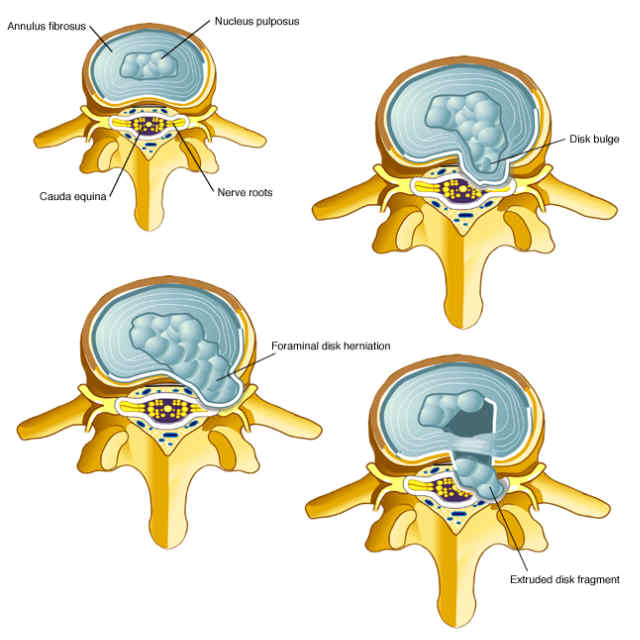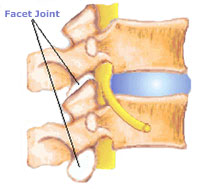What Type of Conditions Respond To Spinal Decompression?
Herniated Disc/ Disc Bulge/ Slipped Disc/ Sciatica/ Pinched Nerve
The disc between our spinal vertebra consist of a soft gel like substance in the middle and more tough fibre rings on the outside. As the spinal disc becomes less elastic it can rupture. When the disc ruptures, a portion of the spinal disc pushes outside its normal boundary. If the fibre rings are still intact then it is referred to a disc bulge, if the gel escapes then it is considered a herniated disc. A slipped disc is simply "slang" for the above conditions. Bulges and herniations can possibly cause pinching of the spinal nerves or spinal cord resulting in a pinched nerve in the neck or low back. Another name for a pinched nerve in the lower back is sciatica.
Common symptoms include;
1) Neck or Low Back Pain
2) Electric Shock Pain in one or more limbs
3) Tingling and Numbness in one or more limbs
4) Muscle Weakness in one or more limbs
5) Loss of Reflexes in one or more limbs
Spinal decompression creates a negative vacuum like pressure to "suck in" or reduce the bulging or herniated disc
Degenerative Disc Disease/ Osteoarthritis/ Spondylosis
Are terms used to describe the gradual break down of the spinal joints. Intevetebral discs lose their flexibility, elasticity, and shock absorbing characteristics. A dry hard disc is more likely to herniate or bulge, causing compression or pinching of nerves. As the stress increases bone spurs and ligament thickening will also effect nerves. This breakdown is believed to be caused by abnormal or excessive mechanical stresses. Initial symptoms are primarily stiffness and deep aching pain in the joints. The loss of flexibility and stiffness tend to be worse in the morning.
Early on patients may experience only joint aches after physical work or activity, which fades and returns when the joint is overused. As cartilage continues to thin and degenerate, the patients symptoms will continue to increase to including pain upon weight bearing such as walking, standing or sitting. As a result patients will begin to avoid certain postures, positions and activities causing weakness in certain muscle groups and ligaments and spasm in other muscles and overgrowth or hypertrophy in other ligaments. Bone spur formation will ensue as the body tries to compensate for the bio mechanical changes occurring. As this occurs further stresses to the joint occurs accelerating and worsening the process. This is the degenerative cycle, an accelerating downward spiral of pain and disability. Spinal decompression is used to halt this cycle.
Spinal Stenosis
This is a medical condition in which the spinal canal narrows and compresses the spinal cord and /or exiting
nerve roots. Spinal stenosis may affect the neck, mid-back or the lower back. Lumbar spinal stenosis results in low back pain and can radiate down the nerves into the hips, legs, thighs, feet or buttocks. Cervical stenosis results in neck pain and can radiate into the shoulders, arms, wrists, and hands.
Although some individuals congenitally have larger or smaller canals than others, the cause of narrowing is usually caused by degenerative factors associated with degenerative disc disease. As the disc dries out and looses height, increased stresses are accumulating on surrounding joint structures causing, bone spurs, osteoarthritis, and thickening of surrounding ligaments..narrowing the channel further. Scar tissue formation as a result of surgical fusion are other factors than can cause spinal stenosis.
Facet Syndrome
Facet Syndrome is generalized low back pain which is worse with arching your back. Facet syndrome which has not resolved with chiropractic care after 4-8 weeks of care should be considered a candidate for spinal decompression.
Failed Back/Neck Surgery
Scar tissue formation as result of surgical fusion may cause symptoms similar to spinal stenosis or there may be a return of the original symptoms that preceded the spinal surgery. Often the spinal segment above or below the area operated on becomes the new source of pain. If failed back surgery is older than 6 months spinal decompression should be an undertaken before any further surgery is considered. Spinal decompression is an one of the few options for those suffering from failed back surgery or for those who are waiting for surgery.
There are certain conditions or pathologies which disqualify you from treatment:
Aortic Aneurysm, Ankylosing Spondylitis, Cancer in the Spine, Cauda Equina Syndrome, Spinal Infection, Paraplegia/Quadriplegia, Pars Defect, Pregnancy, Severe Osteoporosis, Recent Compression Fracture Below L1, Spinal Surgery which involved Screws or Metal Plates or Cages
If you are unsure about whether you qualify for spinal decompression, call our office today for a no obligation free consult to determine if spinal decompression can help you.





